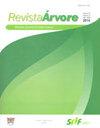PRODUCTIVITY AND QUALITY IN THE PROCESSING WOOD OPERATION FOR ENERGY
IF 0.8
4区 农林科学
Q4 FORESTRY
引用次数: 0
Abstract
ABSTRACT Optimizing resources is essential for the excellence and competitiveness of a forestry company. In this context, this study evaluated the productivity and quality of eucalyptus wood processing for energy purposes. The study was conducted in a forestry company in Paraná State in stands of Eucalyptus urophylla × Eucalyptus grandis and Eucalyptus saligna clones named stands 1 and 2, respectively, with an age of 7 years old. The trees were processed with a harvester and included the following four stem diameter limits for pulp production and co-products for energy purposes: 8, 10, 12, and 14 cm; and pulp logs with a length of 7.20 m. The technical analysis of the operation determined the average operating cycle times, utilization rate and machine productivity. In addition, a quality analysis determined the stem diameter limits for production of the co-products and the lengths of the pulp logs; the limit diameters were compared by the Tukey’s test, and the stands by the Student’s t-test (α ≤ 0.05). The results showed that the processing time decreased with increasing limit diameter, with the highest values being in stand 1 due to the higher number of branches and forked trees. The processing logs at 10 cm limit diameter provided higher harvester productivity, with 59.5 m³ PMH-¹ and 62.2 m³ PMH-¹ in stands 1 and 2, respectively. Furthermore, the best quality in the limit diameter measurement was obtained at 10 cm. Thus, the effects of forest stand and limit diameters on processing and operation quality were evident.木材能源加工作业的生产率和质量
资源优化是林业企业实现卓越和竞争力的关键。在此背景下,本研究评估了用于能源目的的桉树木材加工的生产力和质量。本研究在帕南州某林业公司的尾叶桉×大桉和盐柳桉无性系林分进行,林分分别命名为林分1和林分2,树龄为7岁。这些树是用一台收割机处理的,包括以下四种用于纸浆生产和能源副产品的茎直径限制:8、10、12和14厘米;长7.20 m的纸浆原木。通过对操作的技术分析,确定了平均操作周期次数、利用率和机器生产率。此外,质量分析确定了副产物生产的管材直径限制和纸浆测井长度;极限直径比较采用Tukey检验,采用Student’s t检验(α≤0.05)。结果表明:处理时间随着极限直径的增大而减小,其中1号林分枝条和分枝数量较多,处理时间最大;10 cm极限直径的加工原木提供了更高的收获效率,1号和2号展台分别为59.5 m³PMH-¹和62.2 m³PMH-¹。在10 cm处的极限直径测量质量最好。因此,林分和极限直径对加工和经营质量的影响是明显的。
本文章由计算机程序翻译,如有差异,请以英文原文为准。
求助全文
约1分钟内获得全文
求助全文
来源期刊

Revista Arvore
FORESTRY-
CiteScore
1.00
自引率
0.00%
发文量
32
审稿时长
4-8 weeks
期刊介绍:
A Revista Árvore é um veículo de comunicação científica da Sociedade de Investigações Florestais – SIF. O jornal é de acesso gratuito, revisado por pares, que publica bimestralmente trabalhos científicos originais no campo da Ciência Florestal. As áreas temáticas para publicação são: Ambiência e Conservação da Natureza, Manejo Florestal, Silvicultura e Tecnologia da Madeira e Utilização de Produtos Florestais.
A política editorial visa manter alta conduta ética em relação à publicação e aos seus funcionários, rigor na qualidade dos artigos científicos, seleção de revisores qualificados, respeito profissional aos autores e processo de tomada de decisão imparcial. A Revista Árvore publica artigos apenas em inglês.
Artigos de revisão podem ser publicados se houver uma discussão relevante resumindo o estado da arte sobre o assunto. A revisão estrita da literatura não é aceita.
 求助内容:
求助内容: 应助结果提醒方式:
应助结果提醒方式:


